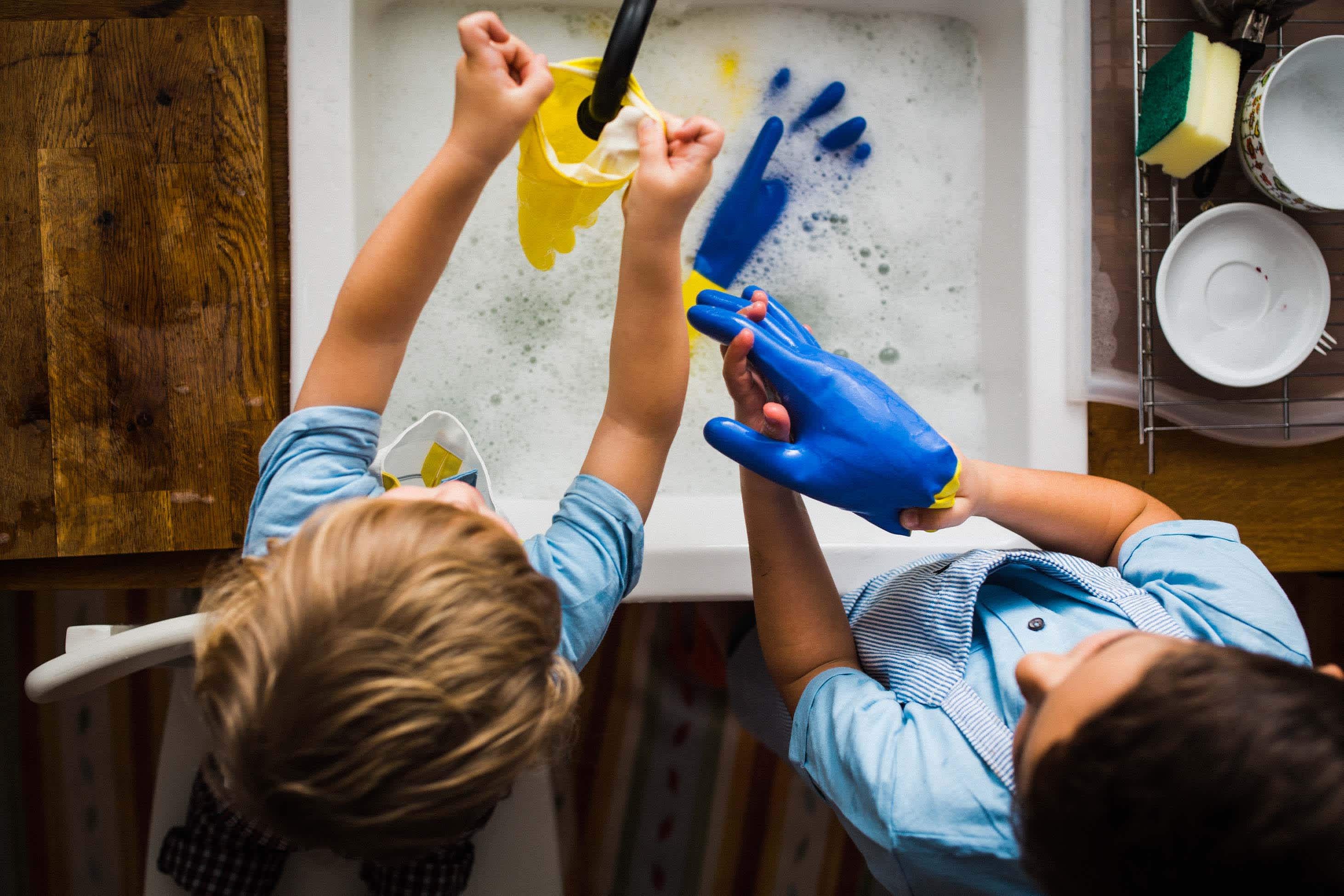Work, Life, Balanced
Fabric’s Top 7 Things to Do When You Have a 7-Year-Old
By Beth Braverman — Feb 11, 2020

Seven-year-olds are no longer “little kids,” but they’re still young enough to believe that their parents know all the answers.
And they’ll expect you to share those answers with them. They're just feeding their natural curiosity by asking you lots of questions about the world. At age 7, kids love to learn and they're especially happy to relay their newfound knowledge to anyone who’ll listen.
Here are Fabric’s top seven things to do when you’ve got a 7-year-old.
1. Put Your Kids to Work!
Your 7-year-old is fully capable of completing some household chores, such as making their bed, clearing dishes or doing yard work. Not only will giving them little tasks lighten your loan, but they’ll also prepare them to be a responsible adult who manages their money, and obligations, with aplomb.
Doing chores can teach your child that everyone in a household must contribute in order to help things run smoothly. They can also start to prepare them for that whole “life requires hard work” thing.
“You’re teaching them that life isn’t all play,” says Roberta Golinkoff, a professor in both the education and the psychology departments at the University of Delaware and author of Becoming Brilliant: What Science Tells Us About Raising Successful Children). “But if we do it together, we make it more fun.”
Plus, if everyone pitches in, there’s more free time—for both parents and children.
2. Use Conflict as a Learning Tool
Second graders often start to grow and define their social circle. That means developing closer friendships with children whom they see or play with often. Of course, spending more time with friends may lead to some conflict.
“That’s par for the course,” Golinkoff says. “They’re human, and even grown-ups have fights with each other over stupid things.”
When disputes arise between your kid and their friends, try to remain neutral and encourage them to find a fair solution. “Don’t just jump in and always take your kid’s side,” child psychologist Kathleen Cuneo says. “You want to be supportive of your child, but you also want to try to get more context and make sure each person is taking responsibility.”
If your child comes home upset about something, ask them to explain what happened and why it’s bothering them. Talk through why they're upset, and discuss options for how they could have handled the situation differently, Golinkoff says.
3. Encourage Empathy
By age 7, kids are starting to understand emotions more clearly, both in themselves and in others, Golinkoff says. Developing empathy at an early age is important for your child’s self-confidence, and it’s been linked to lower stress and better relationships.
To teach empathy, try talking about a recent event in your kid’s life that impacted others. For example, maybe they noticed some friends talking about a party in front of another child who wasn’t invited; discuss how that may have made the other child feel.
Reading is also a great way to learn about unfamiliar situations and cultures that you might not see in your local community. Ask your librarian for suggestions on age-appropriate books with stories about people and places that are different from your own.
4. Start Teaching Kids About Charity
Take your 7-year-old’s empathy to a new level by bringing them into your family’s conversation about charitable giving. The most powerful way to encourage your child to be generous is to model that behavior yourself. Let your child sit in as you and your spouse discuss your family’s annual charity budget, and explain what compels you to give.
If you haven’t already had your child set aside some of their allowance for charity, now’s a good time to start.
One big way to get your children involved is to talk about what matters to them. For example, if they're passionate about animal welfare, try talking about why they care about it. You might even research animal-related charities together so you can make a family donation.
5. Keep Track of Your Old 401(k)s
Now that you have a 7-year-old, you may finally have a few minutes to spare for financial housekeeping. If you graduated sometime in the 2000s, there’s a good chance you’ve already worked at close to four different companies, according to data from LinkedIn. That can mean multiple 401(k) accounts left behind.
Consider rolling over your old accounts into an IRA or into your current 401(k) plan. This can help you streamline your accounting, avoid needless fees and make sure you know how much you have.
6. Check Your Coverage
As a parent, part of your job is making sure that your family is prepared for a worst-case scenario. Take some time to help ensure you’re properly covered—and not overpaying—for insurance for yourself (life, health, disability and long-term care) and your belongings (home and auto).
You may be able to cut some costs by bundling home and auto insurance. Additionally, think about right-sizing the health insurance you purchase through your employer.
When it comes to evaluating your life insurance, consider getting an individual life insurance policy, which you can keep even if you switch jobs. (Fabric lets you apply for term life insurance in only 10 minutes, online.)
7. Let Your Kid Make Mistakes
The impulse to protect our children is strong, but letting them make their own mistakes is a powerful teaching tool—especially when it comes to learning about money.
Let’s say your kid blows all their money on a toy that breaks a few days later. It may be tempting to sweep in and buy them something new. But letting them work through their feelings will teach them the importance of assessing their purchases for quality. Plus, they’ll learn what buyers’ remorse feels like.
“I’d rather them learn those lessons at 7 than at 17 or 27,” says Greg Murset, CEO of BusyKid, a chores and allowance app, and a Certified Financial Planner.
At the same time, kids this age often get upset if they perform below their own expectations in school or at a sporting event. So if your kid does make a mistake, praise them for trying their best and look for ways to set them up for success in the future.
“Sometimes parents just put kids in activities because it’s convenient or others are doing it,” says Cuneo. “But maybe by 7 they realize that soccer isn’t really their thing. Try to make choices based on your kid’s interests and talents. They should have the experience of doing things that they’re good at.”
By the time your child reaches 7 years old, they will already be showing signs of the person they'll eventually to grow into. They're old enough to play games and take on outings that are enjoyable at an adult level, too.
Enjoy the quality time they're glad to spend with you now . . . just wait till they're a teenager.
Skip ahead: 8 things you should know when you have an 8-year-old. Or check out financial to-dos from the first year to age 10.
Fabric exists to help young families master their money. Our articles abide by strict editorial standards.
Information provided is general and educational in nature, is not financial advice, and all products or services discussed may not be offered by Fabric by Gerber Life (“the Company”). The information is not intended to be, and should not be construed as, legal or tax advice. The Company does not provide legal or tax advice. Consult an attorney or tax advisor regarding your specific legal or tax situation. Laws of a specific state or laws relevant to a particular situation may affect the applicability, accuracy, or completeness of this information. Federal and state laws and regulations are complex and are subject to change. The Company makes no warranties with regard to the information or results obtained by its use. The Company disclaims any liability arising out of your use of, or reliance on, the information. The views and opinions of third-party content providers are solely those of the author and not Fabric by Gerber Life.

Written by
Beth Braverman
Related Posts
Work, Life, Balanced
CFPs, Money Coaches and More: Which Financial Professional Is Right for You?
A financial professional can help you manage your money. What type of financial pro you need can depend on the kind of help you’re looking for.
By Jessica Sillers
Work, Life, Balanced
What Parents Need to Know About Taxes in 2025
Tax credits or deductions can help families lower taxes and keep more money to enjoy with your kids.
By Jessica Sillers
Work, Life, Balanced
Does Your Partner Lie About Money? Ways to Find—and Fix—Financial Infidelity
Financial infidelity, or being dishonest about money with your partner, can affect your finances and relationship. Spot unhealthy patterns and learn ways to build money habits that strengthen your bond.
By Jessica Sillers
Fabric Picks
Saving/Investing for Kids
How to Do 30 Days of Financial Self-Care as a Parent
Self-care comes in many forms, including how you handle your money. See how small steps may add up to help improve your financial well-being.
By Jessica Sillers
Life insurance
What to Do at the End of Your Life Insurance Term
Term life insurance, by definition, ends. Check that you’re ready for a smooth transition out of your policy, or take steps to continue the best coverage fit for you.
By Jessica Sillers
Saving/Investing for Kids
Investing Strategies for Beginners
Investing can be a sound strategy to help grow your finances over time. Start by identifying which strategy and account type works best for you.